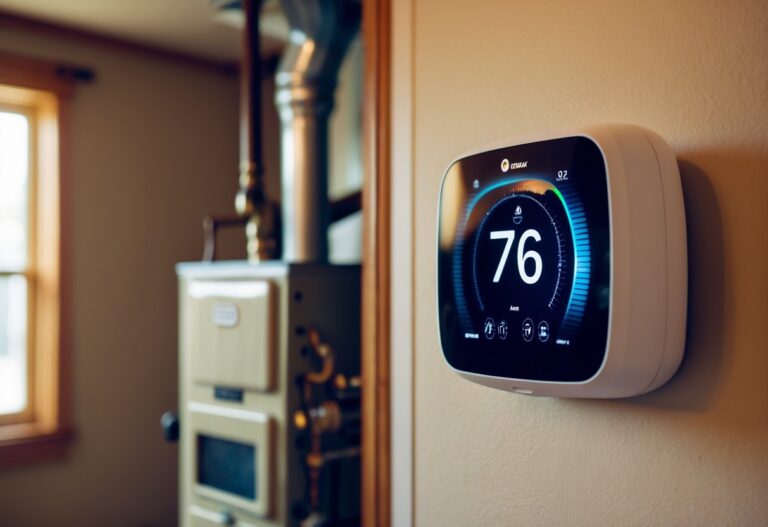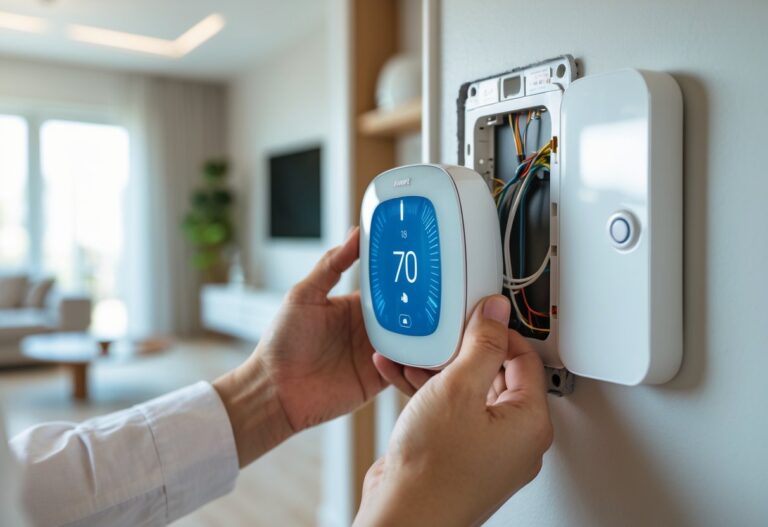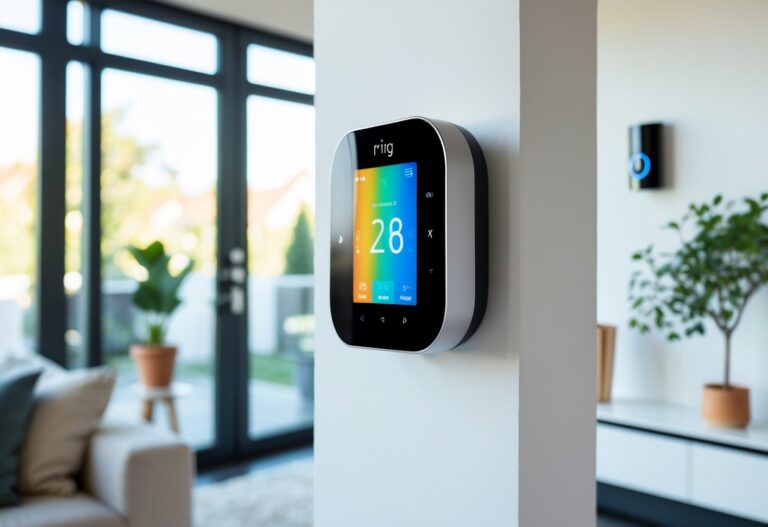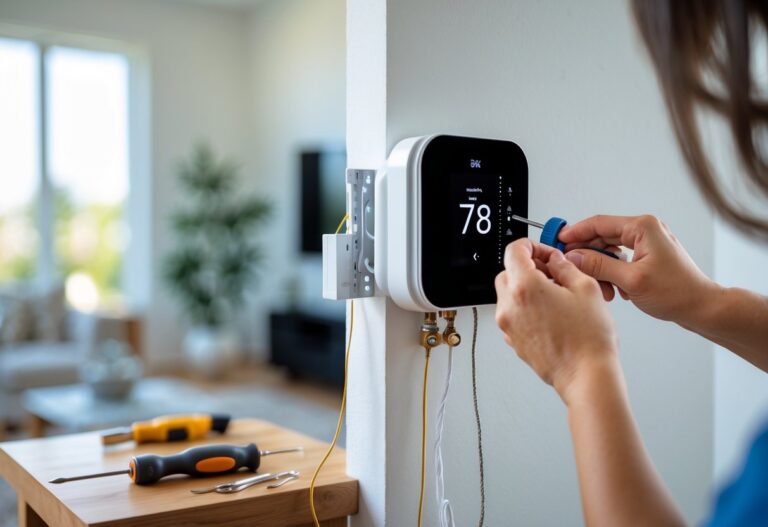If your Lennox smart thermostat is not working, you are not alone. Many homeowners deal with issues like power loss, Wi-Fi problems, or unresponsive controls. You can often fix these issues by checking your Wi-Fi connection, resetting the thermostat, or making sure your system has power.
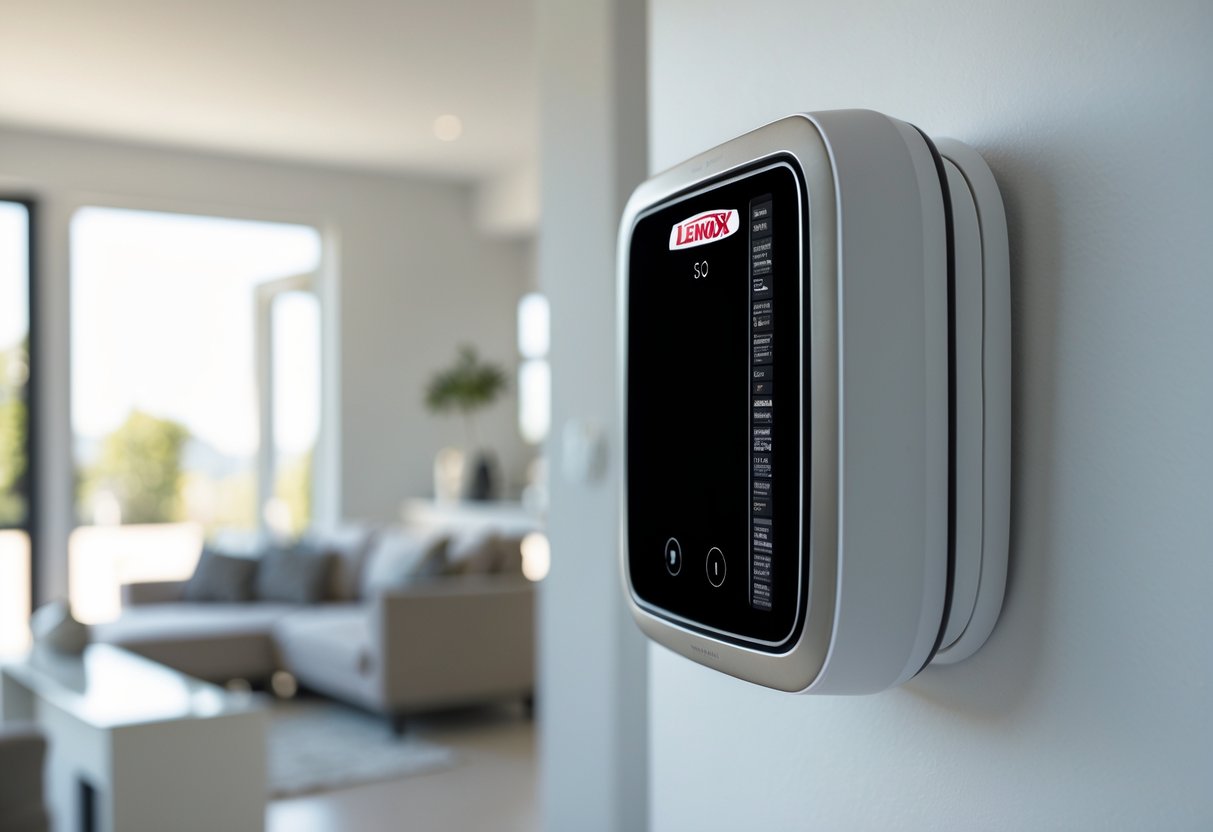
Understanding the most common causes of thermostat problems can save you time and frustration. Small things like a blown fuse, dirty air filters, or even a router placed too far away might be the reason your system is not working as it should.
Key Takeaways
- Smart thermostat issues often come from power, Wi-Fi, or settings problems.
- Simple troubleshooting can solve most problems at home.
- When basic fixes do not work, it may be time to contact professional support.
Common Causes of Lennox Smart Thermostat Issues
Smart thermostats can stop working as expected for several reasons. Many problems are linked to power supply, system compatibility, or sensor problems. Being aware of these causes helps you find solutions faster.
Power and Connectivity Problems
If your Lennox smart thermostat screen is blank or unresponsive, the first thing to check is the power source. Make sure the thermostat is securely connected to its wiring and your circuit breaker is on. Sometimes, a blown low-voltage fuse in the air handler or furnace cuts power to the thermostat. Open your HVAC system panel and look for a small 3–5 amp fuse, usually in a slot on the control board.
Smart thermostats often rely on Wi-Fi for key features. If you lose connection to your home’s network, you may notice delays in temperature adjustments or loss of remote control. Double-check your internet connection and router. Also, check for loose wires behind the wall plate, especially if your home has recently had repairs or upgrades.
If your air filter is dirty, this can cause the HVAC to shut down—leaving your thermostat with no power. Regularly change air filters and keep the area around your air conditioner or air handler clear. Table:
| Issue | What to Check |
|---|---|
| Blank screen | Wiring, circuit breaker, fuse |
| No Wi-Fi connection | Home network, thermostat settings |
| Intermittent power | Loose wires, tripped safety float |
Sensor Malfunctions
Lennox smart thermostats use built-in sensors to monitor temperature, humidity, and sometimes air quality. If these sensors fail, your system may not heat or cool properly. You might notice uneven temperatures in rooms or your air conditioner turning on and off at odd times.
Sensor problems often cause error messages on the thermostat’s display. Check the owner’s manual for your model number to see what specific errors mean. Dust and debris inside the thermostat can block sensors, so gently clean the device with a soft, dry cloth.
If you suspect a sensor malfunction, try resetting the unit or updating its software. Some issues need a professional home repair technician to diagnose, especially if the sensors are inside the HVAC unit rather than the thermostat itself.
Compatibility Concerns
Not every HVAC system works with every Lennox smart thermostat. Before installation, your system’s model number and wiring must match the thermostat’s requirements. If the smart thermostat is not compatible with your current air handler or air conditioner, it might not work at all, or you may lose certain features.
Some older HVAC systems do not have a C-wire (common wire), which is required for most smart thermostats. If your setup is missing this wire, you may need a wiring adapter or professional installation. Check the Lennox website to compare compatibility details by model number.
Incompatible software updates can also cause problems, especially if your smart thermostat auto-updates firmware not suited to your HVAC system. Always verify compatibility before installing new updates. If unsure, consult your Lennox manual or call support for help before you start any home repair work.
Wi-Fi and Network Troubleshooting
When your Lennox smart thermostat is not working, network issues are a common cause. Proper network settings, strong Wi-Fi signals, and compatible routers are key to keeping your device connected.
Connecting to Home Networks
To connect your Lennox smart thermostat to your home’s Wi-Fi, start on the thermostat’s home page and tap Wi-Fi. If it shows “thermostat not registered,” you may need to type in your email address or network information. Make sure Wi-Fi mode is turned on.
If your thermostat can’t find your network, try refreshing the list or entering the SSID manually. The device works with 2.4 GHz networks, not 5 GHz for most models. Double-check your network password for typos.
After entering your details, wait for the thermostat to join the network. If you see a connection error, restart both your thermostat and router.
Wi-Fi Signal Issues
A weak Wi-Fi signal can cause your thermostat to lose its connection or perform slowly. Place your thermostat within range of your router for a strong signal. If your router is far away, consider moving it or adding a Wi-Fi range extender.
Walls, large metal objects, and appliances like microwaves can lower signal strength. Try not to put your thermostat on walls that share space with large appliances. If you have many smart devices connected (like cameras or smart plugs), your Wi-Fi bandwidth may be stretched thin.
To check your Wi-Fi signal, look for a signal icon on your thermostat. If the signal is low, try troubleshooting your network or rebooting your router.
Supported Routers and ISPs
Your Lennox thermostat is compatible with most major router brands such as Linksys, Netgear, Xfinity, D-Link, 2Wire, Actiontec, Motorola, ASUS, Belkin, Verizon, Cisco, and Arris. Make sure your router is updated with the latest firmware.
Some Internet Service Providers (ISPs) use special routers with security settings that may block smart devices. If your thermostat won’t connect, log into your router’s settings and look for options to enable WPA2 security and disable network isolation. These settings often impact device connectivity.
If you have issues connecting on certain ISPs, contact your provider to ask if any settings may block smart device connections. Using a dual band router, set the 2.4 GHz band as open as possible for smart devices.
Thermostat Settings and Feature Problems
Feature issues can stop your Lennox smart thermostat from working as expected. You might see problems with adjusting the temperature, or the schedule may not follow your commands.
Temperature Adjustment Not Responding
If you try to change the temperature and your Lennox iComfort or iComfort S30 does not respond, first check if the display is on and functioning. A blank or frozen screen may mean a power issue or software glitch.
When features like Climate IQ or Feels Like Temperature won’t adjust, look for settings limits that might block changes. Your system may also have Perfect Temp enabled, which can override manual adjustments.
Sometimes, the mobile app or web portal does not sync with the thermostat. In this case:
- Restart the thermostat by turning it off and back on.
- Make sure your WiFi is connected and signals are strong.
- If problems continue, use the reset option found in the menu under Settings > Account.
If these steps do not help, the thermostat may need a firmware update or further technical support.
Scheduling Errors
When the Schedule IQ feature or regular scheduling isn’t working, first check if the correct time and date are set on your smart thermostat. An incorrect clock can cause schedules to start at the wrong time, affecting your climate control.
If your programmed settings do not activate, double-check each scheduled period for overlaps or missing times. The iComfort M30 and S30 models allow you to review and adjust each period:
To fix common schedule issues:
- Use the touchscreen to review your setup.
- Edit or delete settings that do not match your needs.
- Test changes by setting a simple schedule and watching if the thermostat follows your command.
Firmware bugs can also cause scheduling trouble. Updating your thermostat software from the settings menu may solve these errors quickly. If the thermostat still ignores the schedule, contact Lennox support for help.
Smart Home Integration Issues
Smart home devices, like the Lennox smart thermostat, can run into problems when they try to connect with other smart systems. These issues can stop you from controlling your thermostat with your voice or through mobile apps.
Connecting with Alexa, Google Assistant, or Apple HomeKit
Your Lennox smart thermostat may not always connect smoothly to assistants like Alexa, Google Assistant, or Apple HomeKit. Compatibility is the first thing to check. Not all Lennox models work with every smart home system, so you should confirm your thermostat supports the device you want to use.
If your devices are compatible, make sure they are all on the same Wi-Fi network. Using different networks or having a weak signal can cause connection failures. Sometimes, simply moving your smart hub closer to your router helps.
Pairing usually involves enabling the proper skill or app (for example, enabling the Lennox skill in the Amazon Alexa app). You will need to sign in with your Lennox account and follow the steps to add your thermostat.
If you have problems, restarting the thermostat, smart hub, or router can help. For some issues, removing and re-adding the thermostat in your smart home app may solve the problem.
Remote Control and Automation Challenges
Remote control and automation features allow you to set schedules, monitor temperature, and change settings even when you are not home. If these features stop working, it’s often because of a lost connection between the thermostat and your home network.
First, check the Wi-Fi connection on the thermostat. A lost or weak signal can block remote control through apps like Amazon Alexa, Google Assistant, or Apple HomeKit. Updating your thermostat’s firmware may also fix bugs that interfere with remote commands.
Some users notice delays or missed commands. This usually happens if there is a network outage or heavy traffic on your Wi-Fi. Tips:
- Make sure your phone, smart devices, and thermostat are all connected to the internet.
- Reboot the router if you notice slow response times.
- Double-check automations in your smart home app, like routines in Alexa or Apple’s Home app settings.
Advanced smart home systems, like Control4, may require different steps or extra configuration for proper integration. Always follow the manufacturer’s guidelines for setup and troubleshooting.
App and User Account Problems
Problems with the Lennox Home App or your user account can make it hard to control your thermostat from your phone. Issues may involve the app not working, features failing, or trouble logging in to your account.
Lennox Home App Errors
The Lennox Home App may fail to open or crash during use, especially after updates or changes to your thermostat. This often appears as error messages, freezing screens, or your thermostat showing as “offline” even when it is connected to Wi-Fi.
Make sure your mobile device is running the latest version of the app. Both Android and iOS users should check for updates in their app store. If problems continue, try restarting your phone and reinstalling the app.
Your home Wi-Fi network can also affect the app. Weak or unstable signals may cause the system to show the Lennox thermostat as disconnected. In some cases, unregistering the device from the app, then adding it again, can help clear up connection errors.
Thermostat App Features Not Working
Sometimes, only part of the thermostat app fails, like remote temperature control, scheduling, or email updates. When this happens, basic control may work, but advanced features might not.
Check if your internet connection is steady and that your Lennox thermostat itself is online and shows as connected on the app. Some features, such as push alerts and email updates, may require you to enable notifications and set up a valid email address in your user account.
If you still have problems, navigating to the app’s settings and logging out, then logging back in, may resolve blocked features. Make sure to match your thermostat’s firmware version with the app’s supported versions, as out-of-date devices may cause loss of main features.
User Account Access Issues
Account-related problems can block access to app features completely. This may show as an incorrect email or password, being signed out suddenly, or failing to register a new device on your account.
Try resetting your password using the email address linked with your Lennox Home or iComfort account. On the thermostat, you can move through the menu to User Account > Email to start a password reset. In the app, use the “Forgot Password” link found on the login screen.
If you have more than one Lennox thermostat, verify that each device is registered to the same account. Sometimes, unregistering a thermostat and re-adding it will fix stubborn access issues. Always use your current email, and check your inbox for Lennox confirmation emails to complete account actions.
System-Specific Troubleshooting for Lennox Thermostats
Different Lennox smart thermostats often have unique issues tied to their hardware or features. Knowing what problems to look for with each model can help you quickly fix common issues and get your HVAC system running again.
iComfort M30 Problems
The Lennox iComfort M30 may stop working if it loses power or if your Wi-Fi disconnects. First, check that the circuit breaker has not tripped and that the thermostat display is on.
If your M30 screen is blank, replace the batteries if it uses them, and make sure the unit is properly connected to power. A tripped low-voltage fuse in your HVAC system can also cause power loss to the thermostat. Locate the 3-5 amp fuse on the furnace control board and check if it’s blown.
Wi-Fi connection failures are another common issue. Double-check that your router is working and your thermostat is in range. Try restarting both the thermostat and your router. For software or app problems, look for any available software updates in the settings menu.
If the display is frozen, hold the reset button (if present) for a few seconds or power cycle the unit by turning it off and on at the breaker.
iComfort S30 Issues
The iComfort S30 sometimes fails to connect with the Smart Hub or the Lennox Home app. Verify that the Smart Hub is not installed on surfaces that cause vibration or near equipment that interferes with signals.
If you lose remote access or app connectivity, reset your account password under Menu > Settings > Account on the thermostat itself. For persistent network issues, try removing and re-adding the thermostat in your mobile app.
If the thermostat is not responding, confirm that it is receiving power. Check the circuit breaker and inspect the furnace or air handler for a blown fuse. If your HVAC still doesn’t start when the thermostat calls for heating or cooling, check system compatibility and wiring connections.
When experiencing sensor problems, rerun the installation wizard in the settings to recalibrate room and outdoor sensors.
Lennox S40 Smart Thermostat Troubles
The S40 Smart Thermostat may display error codes or may not control your HVAC system correctly if there’s a wiring error or if the thermostat firmware is outdated.
If you see a blank or flashing screen, inspect the wiring at both the thermostat and control board. Make sure terminals are tight and that no wires are loose or out of place. Look for error codes on the thermostat display and check them against the user manual.
For app and smart home integration problems, confirm that your mobile device and thermostat are on the same Wi-Fi network. Restart the thermostat and re-link smart home assistants if necessary.
If your S40 is not regulating temperature correctly, inspect the room temperature sensor placement, avoid sunlight or vents, and update the thermostat firmware through the settings menu if prompted. Also, clean air filters to prevent HVAC performance issues that may affect thermostat readings.
Environmental and Hardware Issues
Environmental factors and physical problems can affect how your Lennox smart thermostat works. These issues may cause errors in climate control, false readings, or even stop the system from running.
Temperature and Humidity Sensor Faults
Your thermostat uses temperature and humidity sensors to control your climate settings. If one of these sensors fails or gives inaccurate readings, you might notice your home feels too hot, cold, dry, or humid even when the display looks normal.
A humidity sensor fault can trigger error alerts and even stop your thermostat from turning on your HVAC system as needed. Sometimes, recalibrating your thermostat can fix minor sensor issues. However, a sensor that consistently reads too high or low will often need to be replaced.
When these sensors provide false data, your system can run at the wrong times. This may cause temperature drops, unexpected humidity changes, or prevent your system from providing comfort. Regularly checking your thermostat for sensor error messages and keeping the area around the device free from dust or direct sunlight can help prevent issues.
Tip: Always check for software updates. Some sensor issues are caused by outdated firmware, which a quick update through the thermostat’s menu may resolve.
Condensation and Drainage Concerns
Condensation is a normal part of cooling, but poor drainage can create hardware problems. If your system’s drain line becomes blocked or your drain pan overflows, moisture may damage sensitive parts of your thermostat or the Equipment Interface Module (EIM).
Signs of drainage issues include water stains around your HVAC unit, excess humidity, or system shut-off. Your thermostat may even stop running to prevent water damage. To help prevent condensation problems, clean or replace your air filters regularly and ensure the drain line is clear.
It helps to check the EIM for moisture or corrosion if you experience any water-related shutdowns. Catching these problems early can keep damage from spreading and reduce repair costs.
Impact of Outdoor Temperature Changes
Large shifts in outdoor temperature can affect your Lennox thermostat’s performance. When the outside temperature drops suddenly, your thermostat might struggle to keep your indoor space comfortable or may run your system for longer periods.
Rapid temperature changes can also cause condensation buildup inside the HVAC system, increasing the risk of drainage issues or ice forming on coils. Both situations may force your thermostat to display fault codes or stop the system to protect hardware.
In areas with extreme weather, positioning the EIM in a spot away from outdoor drafts can limit exposure to rapid temperature swings. Adding insulation to pipes and sealing window leaks will also help your thermostat react more accurately to outdoor changes, improving efficiency and comfort.
Advanced Features Not Working as Expected
Lennox smart thermostats offer several advanced options, allowing you to maximize comfort, manage energy use, and help improve air quality. If these features stop working, it can reduce the value of your device and disrupt your home’s environment.
Smart Away Feature Issues
The Smart Away feature is designed to detect when no one is home using your phone’s location, then adjusts your system to save energy. Problems with this feature often happen when location permissions are not set correctly on your device. If the app cannot reach your phone’s location, Smart Away may not activate or turn off as expected.
A weak or unreliable Wi-Fi connection can also prevent Smart Away from working. Make sure your phone’s location and the thermostat’s app have all the needed permissions. Check that your app, device OS, and the thermostat firmware are up-to-date.
Checklist for Smart Away Problems:
- Location permissions enabled
- Stable internet connection
- Latest app and firmware updates
If Smart Away still isn’t working, try logging out and back into your account or restarting the thermostat.
Allergen Defender Malfunctions
Allergen Defender works by monitoring outdoor air quality and adjusting your system to help filter indoor air. If this function isn’t working, you might notice your air filter system—like the PureAir S—not running more often during high pollen days.
Problems often come from incorrect ZIP code settings or network issues that stop air quality data from updating. Check that your thermostat has the correct ZIP code entered and is connected to the internet. Outdated firmware can also block Allergen Defender.
If the PureAir S system is installed but not responding, look for error messages in the thermostat menu. Sometimes you may need to reset your air cleaner or update the thermostat.
Schedule IQ and Weather Forecast Problems
Schedule IQ helps create a heating and cooling schedule based on your habits and changes. The weather forecast feature lets your thermostat adjust settings for outdoor temperature changes, which can save money on energy costs.
If these features fail, usually it’s from a problem getting weather or schedule data from the server. Make sure your Wi-Fi works with other devices. Restart your internet router if there are issues.
Check your Lennox account login and update your thermostat if the device doesn’t get the local forecast. If settings aren’t saving, delete and recreate your schedules in the thermostat menu. Make sure the time and date are correct, as incorrect info can cause scheduling problems.
Professional Support and Warranty Considerations
Getting help from a qualified Lennox dealer can solve issues you cannot fix on your own. Understanding warranty coverage helps protect your system and avoid unexpected costs.
When to Contact a Lennox Dealer
If your Lennox smart thermostat is not responding, giving error codes, or blank, it may be time to reach out to a Lennox dealer. Problems with wiring, internal parts, or software updates often require professional skills.
You should also seek help if you have tried basic troubleshooting like checking the power, resetting the unit, or changing filters without success.
Contacting a Lennox dealer ensures that safety protections are followed, especially when electrical work is needed. Attempting repairs yourself can lead to further damage or void your warranty. For new installations, or in cases where your HVAC system is also acting up, a dealer can inspect both the thermostat and your larger system in one visit.
Warranty and Replacement Options
Most Lennox smart thermostats come with a limited warranty. This warranty may cover faulty parts or replacement if the thermostat fails due to a manufacturer defect. To use your warranty, keep your purchase receipt and check your policy details for what is included and any exclusions.
Warranties do not cover damage caused by improper installation, misuse, or user repairs. If your thermostat is within warranty, contact your Lennox dealer or the place of purchase to start a replacement. Sometimes, replacement parts will be provided instead of a new thermostat.
Always ask your dealer to confirm your coverage and what steps are next. Under warranty, repairs and replacements may come at no cost, giving important protection for your home improvement investment.
Optimizing Performance and Preventative Maintenance
Maintaining your Lennox smart thermostat helps prevent problems and keeps your system running smoothly. Good care can also make your home more comfortable and may lower energy costs over time.
Routine Care for Smart Thermostats
Check the thermostat’s power supply by looking at your breaker box and making sure the unit is receiving electricity. Replace batteries in your smart thermostat as needed. Batteries that are low can cause system failures or screen display issues.
Clean your thermostat often using a soft, dry cloth to wipe dust from the screen and vents. Dust can block temperature sensors, making your climate control less accurate.
Make sure air filters in your HVAC system are changed regularly, about every 1 to 3 months. Clean filters help sensors and smart air quality monitors work better, and improve whole-home air quality.
Keep the thermostat away from direct sunlight, drafts, or heat sources. Poor placement can give false readings, which can disrupt temperature settings and energy savings.
Update your thermostat’s software whenever updates are available. Most Lennox smart thermostats let you enable automatic updates for the latest features and security patches.
Maximizing Energy Efficiency
Adjust your thermostat settings based on your daily habits. Use the schedule feature to set the temperature lower or higher when you are not at home to save energy.
Pair your thermostat with a Lennox smart room sensor. These sensors help detect the exact temperature in important rooms, allowing for more precise climate control and better energy use.
Add a smart air quality monitor to help track humidity and air quality. Clean air supports both health and HVAC efficiency, reducing system strain.
Use features like adaptive learning if your thermostat supports it. Over time, the device will learn your schedule and adjust temperatures automatically, which can boost both comfort and home improvement efforts.
Check your energy usage reports in the thermostat’s app. Look for patterns and adjust your routines to save energy and lower bills. Small changes in settings can lead to noticeable energy savings throughout the year.
Frequently Asked Questions
Many problems with a Lennox smart thermostat can be traced to power, connection, settings, or alerts. Knowing what each symptom means can help you fix issues quickly and safely.
How do I troubleshoot a Lennox thermostat with a blank screen?
First, check that your thermostat has power. Make sure it’s not switched off and the circuit breaker is on.
Look for a tripped breaker or blown fuse. If your thermostat uses batteries, try replacing them. Also, check if the furnace door is closed securely, because some units will not power on if the door is open.
What steps should I take if my Lennox thermostat’s touch screen is unresponsive?
Try resetting the thermostat by briefly turning off power at the breaker, then turning it back on. This can reboot the device.
If the screen is still stuck, check for dirt or debris and clean carefully. If these steps do not help, you may need professional assistance.
How can I resolve communication issues between my Lennox thermostat and the smart hub?
First, confirm that your Wi-Fi network is working and the signal is strong near the thermostat.
Restart your router and the thermostat. Make sure you enter the correct Wi-Fi password during setup. If the problem continues, check for software updates for both the thermostat and the hub.
What is the procedure for resetting a Lennox smart thermostat?
Go to your thermostat’s menu, then find the settings option. Look for a reset or account section.
For some models, you may need to log into your account and use the reset option under account settings. If you own an S40 smart thermostat, contact Lennox support or your dealer for reset instructions.
How do I replace the battery in a Lennox iComfort thermostat?
Most Lennox iComfort smart thermostats do not use batteries, as they get power from your HVAC system wires.
If your model has a battery, check your user manual for specific steps. Usually, you will remove the front cover and replace the battery inside.
Why is there a red light on my Lennox smart thermostat and what does it mean?
A red light usually signals a problem or system alert. It can mean heating or cooling is not working, or there is an error with the unit.
Look at the screen for error messages and follow the recommended steps shown. If you need help, contact your HVAC professional.
